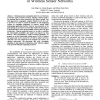Free Online Productivity Tools
i2Speak
i2Symbol
i2OCR
iTex2Img
iWeb2Print
iWeb2Shot
i2Type
iPdf2Split
iPdf2Merge
i2Bopomofo
i2Arabic
i2Style
i2Image
i2PDF
iLatex2Rtf
Sci2ools
GLOBECOM
2006
IEEE
2006
IEEE
Honeycomb Architecture for Energy Conservation in Wireless Sensor Networks
— Reducing energy consumption has been a recent focus of wireless sensor network research. Topology control explores the potential that a dense network has for energy savings. One such approach is Geographic Adaptive Fidelity (GAF) [1]. GAF is proved to be able to extend the lifetime of self-configuring systems by exploiting redundancy to conserve energy while maintaining application fidelity. However the properties of the grid topology in GAF have not been fully studied. In this paper it is shown that there exists an unreachable corner in the GAF grid architecture. Using an analytical model, we are able to calculate the unreachable probability and analyse its impacts on data delivery. After investigating a couple of lossless topologies, we propose to use the Honeycomb virtual mesh (GAF-h) to replace the square grid. GAF-h is proved to be able to achieve zero loss with little extra cost compared to the original GAF scheme. An efficient honeycomb cell placement and node association al...
Related Content
| Added | 11 Jun 2010 |
| Updated | 11 Jun 2010 |
| Type | Conference |
| Year | 2006 |
| Where | GLOBECOM |
| Authors | Ren Ping Liu, Glynn Rogers, Sihui Zhou |
Comments (0)

